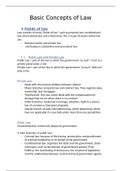Basic Concepts of Law
1.Fields of law
Law consists of many “fields of law”, such as property law, constitutional
law, international law, and criminal law. The 2 major divisions within law
are:
- between public and private law
- and between substantive and procedural law.
1.1. Public Law and Private Law
Public Law = part of the law in which the government “as such” (=not as a
private party) plays a role
Private Law = part of the law in which the government “as such” does not
play a role
Private Law:
- Deals with the mutual relations between citizens
- Major branches: property law and contract law. They regulate sales,
ownership, and mortgages
- Third branch: tort law, which deals with the compensation for
damage that occurs when there is no contract
- Other branches: family law (marriage, adoption, right to a name),
law of commerce (transport of goods)
- Special branch: private international law, which determines which
laws are applicable if a case falls under more than one jurisdiction
Public Law:
Characterized by central role played by government
4 main branches of public law:
- Criminal law: because of the tracing, prosecution, and punishment
of criminal handled by or on behalf of the government
- Constitutional law: organizes the State and the government, deals
with topics such as the division of government powers (Trias
Politica), the functioning of democracy, the creation of legislation,
and the relationship between central and local government agents.
, Also deals with human rights (traditionally) but is now more of
public international law
- Administrative law: deals with the many interactions between
government agents and civilians or private organizations. Many
branches within administrative law: social security law,
environmental law, tax law
- Public international law: regulates relations between States and
international organizations
European Union Law:
Illustrates that the division between private and public law is not always
clear-cut:
- Treaties between the member States of the EU in which the main
institutions of the EU are regulated.
Kind of public law because these rules are very much like the
constitutional law of the individual member States
Kind of public international law as this law is created in the form
of treaties between States
- EU institutions also make law themselves, in a way that is similar to
constitutional law, but also deals with the relationship between
citizens and companies within the EU (EU rules about fair
competition that focus on citizens and companies belong to
private law)
1.2. Substantive and Procedural Law
Division between substantive (rules that give people rights and determine
what people should do) and procedural law.
Procedural law gives the means to comply duties and respect rights of
legal subjects, it provides the rules for court procedures and for the
organization of the judiciary. Also includes rules that specify how judicial
orders can be enforced.
There are branches of procedural law for each of the major branches of
substantive law:
Rules for civil procedure (enforcement of private law) rules for
criminal procedure (specifies how criminal suspects can be traced,
prosecuted and –after conviction- punished.





